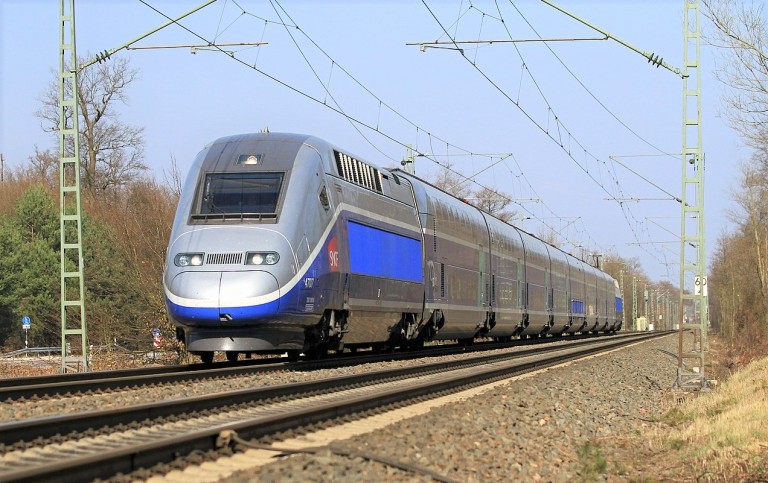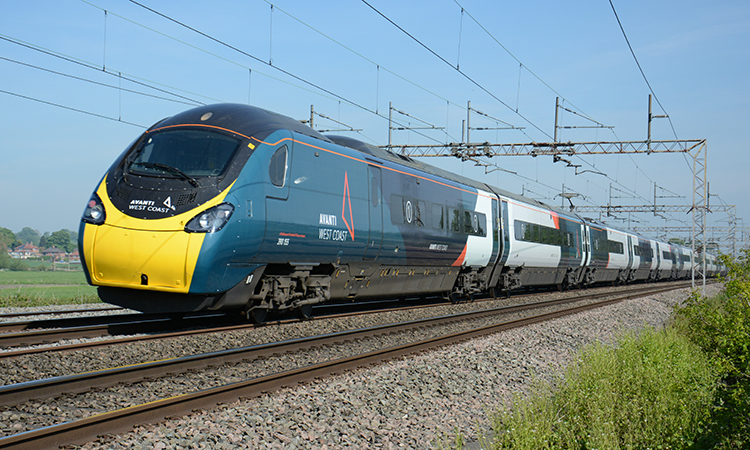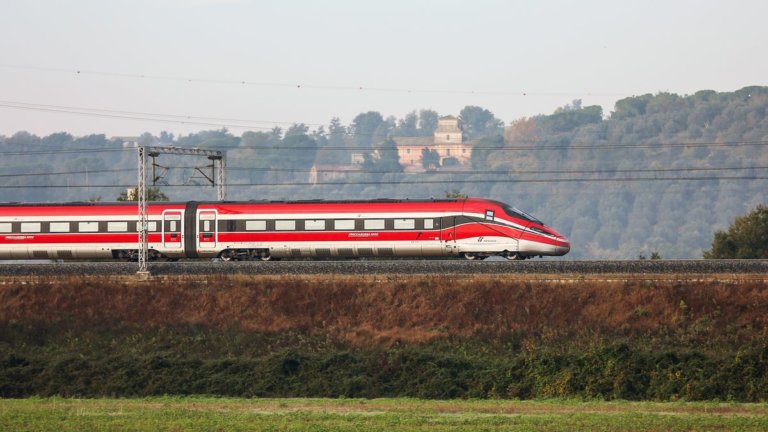(Above : line up of ICE 1 to ICE 4 – photo Deutsche Bahn)
30/05/2021 – By Frédéric de Kemmeter – Railway signalling
Suscribe my blog
10 years after the launch of the first high-speed train in France, Germany launched its own high-speed train called « InterCity Express » (ICE). This is an opportunity to look back at the German concept, which differs from the French options. The arrival of the ICE has allowed Deutsche Bahn – and Siemens -, to become one of the world’s leading high-speed railways.
The historical timeline shows that it was the Japanese who began to operate this type of train in 1964, followed by the Italians. The earliest European high-speed railway to be built was the Italian Florence–Rome high-speed railway (also called « Direttissima »), which was built between 1978 and 1992.
The European Union Directive 96/48/EC, Annex 1 defines high-speed rail in terms of infrastructure, minimum speed limit and operating conditions. For the International Union of Railways (UIC) high-speed rail a high-speed train is considered to be a train running at more than 250km/h, on a line dedicated to this speed (category 1). This definition is important because some still refer to trains exceeding 200km/h as « high speed ». This is not really the case. Thus, the British HST 125, although described as a ‘high-speed train’, was never a TGV in the French sense.
These details show that in Germany, high speed meant building new lines through the newly reunited country anyway. However, Deutsche Bahn has taken different options from SNCF.
First of all, there is the network of cities: it is more important in Germany, where the geography shows us that there are major cities every 100 kilometres or less. This implies more frequent stops than in France, where the cities are further apart. Another major difference is that in Germany there is no centralism on a single large city as in France, where the high-speed network reaches Paris as a priority.
In the 1980s, it was customary for the railways’ design offices to study and design the rolling stock. The industrialists were then simply subcontractors making a tailor-made train. This is why Deutsche Bahn’s ICEs are pure products of German industry, at a time when Europe without borders did not exist.
In France, Italy and Germany, the history of high-speed rail was was initially that of state support through scientific research programmes. In 1979, while Germany was studying its famous Transrapid magnetic levitation train, the Federal Ministry of Research and Technology commissions the development of a concept for a « wheel/rail test and demonstration vehicle » for high-speed travel. It was preferred to push the limits of traditional wheel/rail technology rather than engage in technologies that were too disruptive at the time.

The Deutsche Bahn, together with the national industry, built the InterCity Experimental (also called ICE/V for Versuch = test). This train, which was designed from the end of 1979, was built between 1983 and 1985 and was used for various tests until it was taken out of service on 1 January 2000. It was a short trainset with two power cars and three coaches. Its maximum speed was 350 km/h. The train was also a showcase for German industry, including Krupp, Henschel, Krauss-Maffei, Siemens, AEG, BBC and Thyssen-Henschel.
In 1985, the first test run was made from Munich Freimarn to Ingolstadt and back in September. On 26 November, the ICE/V sets a new German railway record: on the Bielefeld-Hamm line, it travels faster than 300 km/h for the first time. In 1988, the ICE/V sets a world record of 406.9 km/h on the new Fulda-Würzburg high-speed line. The design of the train shows a major difference with the French TGV. The Germans, like the Japanese and the Italians, preferred to retain the classic solution with cars which have two conventional bogies, and could be uncoupled, allowing the train to be lengthened or shortened. This architecture will be that of all ICEs subsequently produced by German industry.
On 2 June 1991, the ICE concept was introduced with only 19 ICE1 trainsets available. The first ICE was the 5.58 a.m. between Hamburg and Munich. The only high-speed section was available between Hanover and Würzburg, which is a 327-kilometre line with 63 tunnels and more than 34 bridges, built from 1973 and put into service in stages between 1988 and 1991. Another 99km line was commissioned at the same time, between Mannheim and Stuttgart, with 12 tunnels and 6 bridges.

Here we find another difference with France. In Germany, the new lines also carry conventional trains and freight trains at night. In this case, the infrastructure had to be designed with a minimum of gradients, which meant a lot of engineering structures. The 177-kilometre new line between Cologne and Frankfurt, opened in 2002, is the only one designed specifically for high-speed trains, with gradients of up to 40 per thousand.
The rolling stock in use in 1991 consisted of 58 ICE 1 trainsets, consisting of 12 cars between two power cars, totalling 365m with a capacity of 649 seats. They were built between 1988 and 1993 by Siemens, KM, Henschel, AEG, Krupp, Düwag, WU, BBC, LHB, MAN and MBB. On 27 September 1992, an ICE arrived at Zurich station for the first time. Switzerland thus became the first country to have two types of high-speed train on its rail network: the ICE and the TGV-PSE.

One of the demands of German customers was the maintain on board the new Intercity of a « real » restaurant. The restaurant car, also referred to as Bordrestaurant, has a total of 40 seats. The restaurant car can easily be recognized by its raised roof, which is 450 mm higher than the rest of the train. This was necessary in order for all the kitchen equipment to fit into the car. Unlike all other intermediate cars, the restaurant car has no sideways doors for passengers to enter or exit the car from the platform. There is, however, a door in the kitchen area that can only be opened from inside.
In terms of train service, the ICEs were integrated into the long-distance timetable that Deutsche Bahn had been famous for since 1979. For this reason – and this is another difference with the SNCF – DB continued to operate many Intercity by conventional pulled-trains, with both types of train co-existing in a comprehensive national service.

Fifth in the world
As a result, a total of 1,571km of lines have been built for a speed at least 250km/h, making Germany the fifth largest « high speed train » country in the world. Between 2005 and 2008, the ICE 1 trains were redesigned with thinner seats, increasing the capacity by about 10%. With the introduction of the ICE 2 between 1995 and 1997, DB wanted to better match demand on certain Intercity sections, where a 7-car train was more than sufficient. The shortening of the trains required only one power car, hence the introduction of the driver’s car at the other end. In addition, the experience gained from operating the ICE 1 had enabled the ICE 2 to benefit from a number of improvements. The weight of the cars was reduced by 5 tonnes, thanks in particular to the lighter seats, the use of aluminium, the insulating but thinner walls and the bogies.
The end of the 1990s and the beginning of 2000 also coincided with a major restructuring of the German railway industry, with the takeover of many medium-sized companies by Siemens, Bombardier and Alstom. It became customary to label ICEs as a « Siemens product », just as French TGVs are still labelled « Alstom ». This ‘national branding’ remains an inescapable barrier to this day: there are no TGVs at Deutsche Bahn and no ICEs at SNCF. Bombardier, which designed its own high-speed train in China under the name Zefiro, was never able to enter the German market and had to settle for Trenitalia.

With an expectation to exporting, Siemens set about designing a new train, different from the first two ICE series. The fundamental characteristic of the ICE 3, which arrived on the high-speed market between 2000 and 2006, is the motorisation distributed throughout the trainset, making it a true high-speed motor unit. Siemens, unlike Alstom, thus turned its back on the engine + car design, an option still defended by Alstom. These 8-car trainsets with a capacity of 454 seats became the Siemens’ « Velaro » platform. 50 15kV single-current and 17 multi-current trainsets were built. They were – and some still are – used on the Frankfurt-Paris, Frankfurt-Brussels and Frankfurt-Amsterdam routes.
Renfe in Spain as well as Russia opted for the ICE 3. There followed a redesigned version of the ICE 3 in the form of the Velaro UK (Eurostar), Velaro-D (Germany) and even Velaro-TK (Turkey). In the meantime, Siemens introduced the ICE-T (tilting) and two years later the ICE TD (tilting but with diesel traction), specially designed for use on routes not developed for high-speed traffic. The trains tilted up to 8° on curves, but this equipment was widely prone to various breakdowns.

The most recent is the ICE 4. The initial contract with Siemens, signed 2011 specified a design allowing flexible train make-up (between 5 and 14 units), with 24 different variants defined; each composed of motor cars, and trailer cars. On 26 September 2018, the DB board approved the purchase of 18 additional seven-car trainsets and 50 individual cars to be added to trainsets then on order. In 2020, it was announced that up to 50 13-car configurations would be put into service from 2021. These longer trains will be 374 meters long and carry up to 918 passengers. Their top speed will also be higher than other models, at 265 km/h.
And now?
In the absence of the pandemic, approximately 100 million passengers were carried annually on ICEs, out of a total of 140 million mainline passengers. Around 200 stations in Germany are called by an ICE service, as well as around 50 in neighboring countries. 330 trainsets are available for daily service. In thirty years, the ICE has kept Deutsche Bahn – and Germany – at the heart of the high-speed rail system, alongside France, Italy, Spain, Benelux and soon, Great Britain. Happy Birthday!

>>> Others news here
Suscribe by mail to connect with railway information
Other related articles:
 High speed train remains still necessary for modal shift
High speed train remains still necessary for modal shift
11/23/2020 – Modal shift does not mean the slow train but the train at the front of the stage. For this, high-speed rail is still largely necessary for Green Deal and to save a maximum of CO2
 How Alstom wants to force mainline competition in Germany
How Alstom wants to force mainline competition in Germany
02/22/2021 – DB has very little competition in the mainline segment and mainly opts for the same supplier. However, a manufacturer would like to change this in order to shake up the homeland of Siemens.
 The productive use of rail travel: what ask customers?
The productive use of rail travel: what ask customers?
03/08/2021 – How can we make the rail journey more timely? There is still a lot of work to be done, but rail has some arguments to achieve this. xxxxxxxxxxxxxxxxxxxxxxxxxxxxxxxxxxxxxxx xxxx
 Trenitalia, a company that looks at Europe and the world
Trenitalia, a company that looks at Europe and the world
02/15/2021 – For most of us, Trenitalia is rather unknown and very few people know about the internationalisation of this Italian state operator. The opportunity for a short overview
 More operators are needed to contribute to more modal shift
More operators are needed to contribute to more modal shift
08/16/2020 – The railway is not able to cover a maximum of our mobility needs. Not really because there are other modes of transport, but because there are not enough operators and innovation.


Vous devez être connecté pour poster un commentaire.